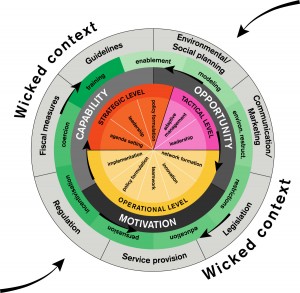Is there is any th ing implementation scientists like more than a fancy figure? I think not. All the most highly cited articles seem to have one.
ing implementation scientists like more than a fancy figure? I think not. All the most highly cited articles seem to have one.
This spring's entrance into the pageant is the Behavior Change Ball, shown here in action, in what is surely the most dynamic illustration in the short history of the field. It appeared in this article that appeared in April in the on-line journal, Implementation Science.
The model involves what the authors call integrated policies to address what they call wicked public health problems existing in wicked contexts.The authors seemed most concerned with obesity, but they have nailed the proper language for the problems we social service folks tackle (think child maltreatment, juvenile violence, substance abuse) and where we tackle them (impoverished communities).
Integrated policies involve how a policy initiated at the top of a system is integrated in practice by program heads through street level actors. Their versions of these organizational levels are: strategic level, tactical level and operational level. A policy that is integrated has aligned actions through the hierarchy.
 The key behaviors at the strategic level are agenda setting, leading (mostly influencing and gathering momentum) and developing policy. At the tactical level, key behaviors are taking an adaptive approach (creating evidence, using evidence) to seeing what works, and leading the change process. Operational level behaviors include teamwork and network facilitation.
The key behaviors at the strategic level are agenda setting, leading (mostly influencing and gathering momentum) and developing policy. At the tactical level, key behaviors are taking an adaptive approach (creating evidence, using evidence) to seeing what works, and leading the change process. Operational level behaviors include teamwork and network facilitation.
Obviously, the ball includes much more than these behaviors. Implementation is complex stuff, we know. A lot of things have to go right in order to have anything effectively implemented over time in multiple places. Everything is multiply determined and affects many actors and domains of behavior.
It raises the questions of whether our models are getting too complex to be helpful to those in charge of implementing change. I am not sure I can take this to the agencies with whom I work.
On the other hand, the Behavior Change Ball is a great idea for a fundraising party. Everyone leaves changed for the better. Who wouldn't pay to attend that?
The lead author of the article was Anna-Marie Hendriks. The author team is from the Netherlands, mostly from Maastricht University.

Hi, Curtis –
Great blog! I evaluate childhood obesity prevention policy and environmental interventions and focus a lot on implementation so I had high hopes for this article until I opened it. Not trying to be cruel to the authors since I think most of the content is generally accurate, but the behavior change ball is the most unintentionally hilarious thing I’ve ever seen. I can’t even imagine what would be the reaction by our community partners if I brought this thing out (the kids might like it for soccer though).
Infographics seem to be getting worse and worse in public health (probably no different than in social sciences or political science or anywhere else). The Flowing Data blog and Andrew Gelman’s blog have enjoyable take-downs of infographics like this from time to time. This one seems to occupy the rarefied space between both unattractive design and lack of utility. I don’t know if its that the model is too complex in this case but rather the presentation of the model is overly complex. It sounds like their intent is to have policy-makers review organizational behaviors that may inhibit or support policy change, specifically integrated health policy change. I don’t think their model is in any way directed towards that at least in presentation. Generally, I think tailoring models can be useful – high level context, then drilled down to what that particular audience wants/needs. But this one is bad even for researchers and folks fluent in jargon and theory. I’m still trying to wrap my head around it. And their statement: “The target group of our framework consists of the local policy-makers who are involved in developing integrated public health policies” is rather silly of them – have they ever met a local policy maker? I guarantee the city department head would laugh you out of her office if you showed her this. And what action steps would you have them take away from this?
Anyways, I’ve rambled on enough. Thanks for sharing this and the other posts – really been enjoying the blog!